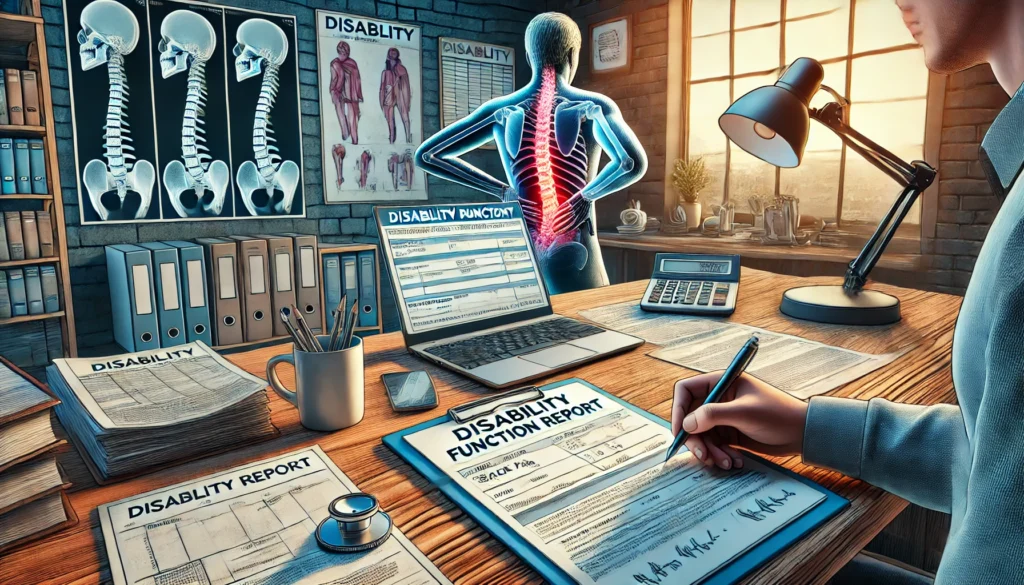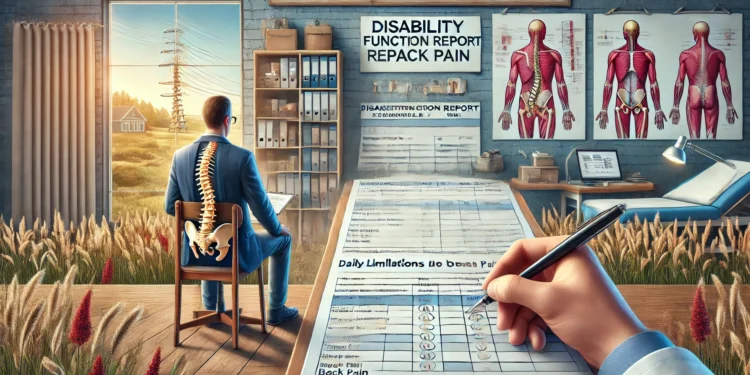When you are applying for disability benefits due to back pain, a critical part of your application is the Disability Function Report (DFR). This document helps the Social Security Administration (SSA) understand how your condition affects your daily activities and your ability to work. Writing a clear and thorough Disability Function Report with relevant examples is essential to improving your chances of approval.
In this article, we will guide you through the key components of the Disability Function Report for back pain and provide example answers to help you articulate how the condition affects your life.
What is a Disability Function Report?
The Disability Function Report is a form that collects detailed information about how your medical condition impacts your daily life. It asks about your physical, mental, and emotional abilities, including how your back pain affects your ability to perform routine tasks such as bathing, dressing, walking, and sitting. Your answers should paint a comprehensive picture of how debilitating your back pain is and why it prevents you from working.
Key Areas in the Disability Function Report for Back Pain
When completing the DFR, you’ll be asked several questions in different sections. Let’s break them down and look at example answers tailored to someone experiencing back pain.
Personal Care (Bathing, Dressing, Grooming)
Can you take care of your personal hygiene (bathing, brushing your teeth, grooming)?
I struggle significantly with personal care due to my back pain. I can bathe but require assistance getting in and out of the tub. I cannot stand for long enough to wash myself thoroughly. Brushing my teeth is difficult because standing or bending over for any length of time intensifies the pain. I can dress myself, but I need to sit down to put on socks or shoes. I often need help with tasks like bending down to pick up clothes or reaching up to grab items from high shelves.
Walking and Mobility
How far can you walk without discomfort? Do you need a cane or other mobility aid?
I can walk for about 10-15 minutes before the pain becomes unbearable. After walking, I often experience sharp pain and stiffness in my lower back. On days when the pain is particularly severe, I need a cane to stabilize myself. I sometimes use a walker if the pain is severe enough to make standing or walking dangerous. Simple tasks like walking to the mailbox or going grocery shopping are often difficult.
Sitting and Standing
Can you sit for extended periods of time or stand for long periods?
Sitting or standing for long periods is extremely painful for me. If I sit for more than 30 minutes, my lower back becomes stiff and the pain radiates down my legs. I can’t sit through meetings or long car rides without shifting frequently or standing up. I often have to stand up and stretch to relieve the pressure. When I stand, the pain in my back intensifies, and I get shooting pain in my legs, especially after about 15 minutes.
Using Hands and Arms
Can you use your hands for tasks like cooking, typing, or holding objects?
I can use my hands for light tasks like typing, but I need to take frequent breaks. Cooking is challenging because standing in the kitchen for long periods causes my back pain to worsen. I find it difficult to lift pots, pans, or heavy objects, especially if they require bending. I have difficulty holding items for an extended period, and tasks like vacuuming or carrying groceries often cause intense pain and fatigue.
Sleep Patterns and Rest
How does your back pain affect your sleep?
My back pain severely affects my sleep. I have difficulty getting comfortable in bed, and I often wake up several times throughout the night due to pain. I cannot sleep in one position for long, so I frequently have to change positions. Even with medication, I wake up feeling exhausted because the pain keeps me from getting a restful sleep.
Social and Recreational Activities
Are you able to engage in social or recreational activities?
I find it difficult to engage in social activities or hobbies that I once enjoyed. I used to walk with friends or go on outings, but now I have to decline invitations because I can’t walk for long periods or stand. I can no longer play with my children or participate in family events that involve physical activity. This has impacted my mental well-being as well, causing me to feel isolated and depressed.
Ability to Work
How does your back pain prevent you from working?
I can no longer perform my previous job due to the physical demands it requires. My back pain makes it impossible to lift heavy objects, bend frequently, or stand for long hours. I used to work as a warehouse manager, but I can no longer handle the physical aspect of the job. Even desk jobs are challenging, as sitting for extended periods causes pain and discomfort. My back pain also affects my concentration, and I often need to take breaks, which makes it hard to stay productive.
Tips for Completing the Disability Function Report for Back Pain

- Be Honest and Detailed: Provide accurate information, even if you feel your pain is not always severe. The SSA needs a complete picture of your condition, so include details about the specific tasks that are difficult for you.
- Describe Limitations: Focus on how your condition limits your ability to perform everyday activities. Avoid simply stating that you have back pain—explain how it impacts your life and why it keeps you from working.
- Provide Examples: Whenever possible, include real-life examples to demonstrate the extent of your limitations. For example, explain how long you can walk before needing to stop or how many hours you can sit before experiencing pain.
- Mention Medications and Treatments: List any treatments, therapies, or medications you are receiving. If your treatment doesn’t fully relieve the pain, explain how it still affects your daily life.
- Use Clear, Simple Language: Make sure your answers are easy to understand. Avoid using medical jargon unless necessary, and focus on how your condition affects your ability to perform daily tasks.
FAQs:
1 What is a Disability Function Report?
It is a form that describes how your medical condition, like back pain, affects your daily life and work ability.
2 How do I describe the impact of back pain on personal care?
Explain specific tasks, like bathing or dressing, that are difficult or require assistance due to your back pain.
3 How can I show how back pain affects my ability to walk or stand?
Mention how long you can walk or stand before pain starts, and whether you need mobility aids like a cane or walker.
4 Can I mention medication and treatments in the report?
Yes, include any treatments or medications you’re using and how they affect your daily life and pain levels.
5 How should I explain my inability to work?
Describe specific job tasks you can no longer perform due to back pain, such as lifting or sitting for extended periods
Conclusion:
Completing a Disability Function Report for back pain can feel overwhelming, but with the right approach, you can effectively communicate the impact of your condition. By providing detailed, honest, and specific examples, you can give the SSA a clear understanding of how back pain limits your ability to work and perform daily activities.If you need help filling out the report or have concerns about how to present your case, consider consulting with a healthcare provider, disability lawyer, or other professional who can guide you through the process.
Read More Relevant Article:
- Read Also: Can Xanax Help Back Pain? A Comprehensive Guide – Is Xanax Effective for Relieving Back Pain!
- Read Also: Best Sofa for Back Pain Sufferers: A Comprehensive Guide to Comfort and Support – Top Sofas for Relieving Back Pain!
- Read Also: How to Relieve Back Pain from Large Breasts – Effective Ways to Relieve Back Pain Caused by Large Breasts!











